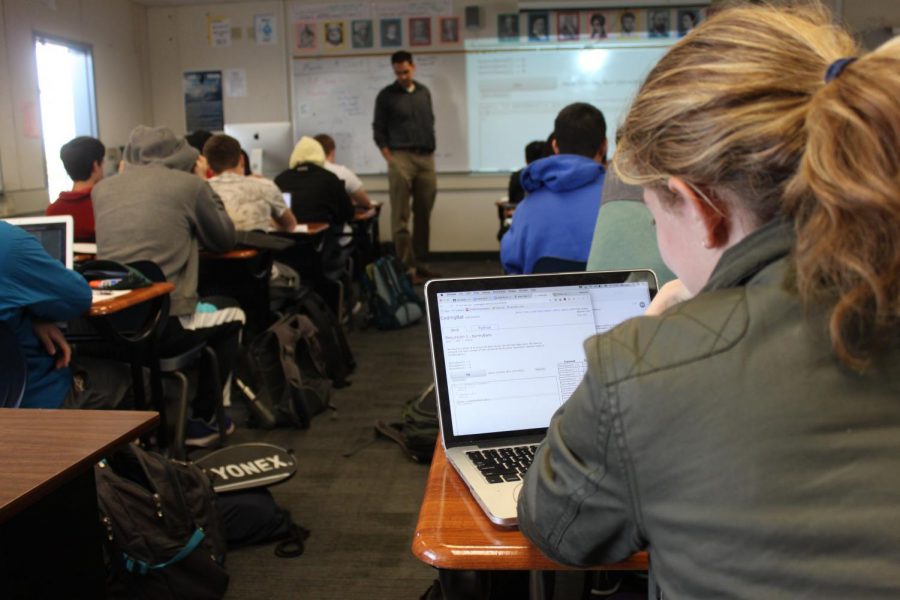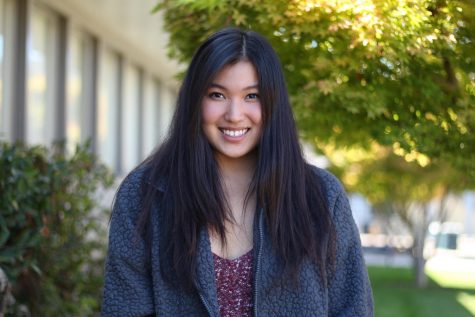Advanced Computer Science Course to be Offered Next Year
Intended for students who have completed AP CS, the class will culminate in developing Android apps.
Sophomore Kat Nasif works on a simulation to learn about recursion on Java in AP Computer Science. Los Altos will offer a computer science course in a partnership with Foothill College next year, where students who have completed AP CS can learn about advanced data structures and Android app development. Kristen Fan.
March 21, 2018
Los Altos next year will team up with Foothill College to offer a new college-level computer science course for students who have completed AP Computer Science and want to develop apps for Android.
The course, Advanced Java Programming and Writing Apps for Android in Java, will fulfill the need for a third computer science class more advanced than AP CS, which more sophomores and juniors are completing instead of in their senior year.
Through partnering with Foothill College, Los Altos will grant students the opportunity to take computer science courses on campus that are normally taken in freshman year of college. In recent years, Los Altos has partnered with Foothill College to provide the college-level Multivariable Calculus course.
Computer science teacher Brent Smith and administration reached out to Foothill College to propose the course three years ago, but it will be implemented next school year because of more demonstrated student interest. Fifty-five students in 2016-2017 and 76 students this year in AP CS were in their junior year or below. Currently, there isn’t another class that students could take after AP CS, so some students would have had to either pay to attend a Foothill class or learn by themselves outside of school.
“If this class wasn’t implemented next year, I would’ve gone to Foothill to take [the same courses],” sophomore Daniel Lim, who’s taking the course next year, said. “I really didn’t want to go to to Foothill every day because I’ve taken Foothill courses before and it’s a hassle to get there.”
After surveying his students two years ago, Smith recognized that 55 percent of the 52 students that participated would take this new course the following year. Out of the 52 students, 69 percent of them wanted the course to include writing apps for Android in Java.
“Most importantly for me, it’s the idea that you are in high school but there’s an opportunity for you to take college-level classes while you’re still in high school,” Foothill College Dean of Physical Sciences, Math and Engineering Ram Subramaniam said. “High school students that already experience college level classes seem to have a much greater chance of succeeding in college. Getting students to and through college is a high priority for us, so this is something I have a major passion for.”
Although the course has no assigned teacher yet, it will be modeled similarly to the current Multivariable Calculus course taught by Foothill professor Douglas Lublin. Advanced Java Programming and Writing Apps for Android in Java will combine three different courses, each taught in 12 weeks: Intermediate Software Design in Java, Advanced Data Structures and Algorithms in Java, and App Development with Java.
“Students were really excited about writing apps for Android and Java, so in order to get there, we needed to establish the previous two foundation level classes,” Subramaniam said.
By having a Foothill professor teach on campus, students won’t have to pay for enrollment, textbook fees, material fees and a parking fee like a regular college student would have to. This new class will also give students an opportunity to learn a college-level course without being packed into a lecture hall with hundreds of other students like they would usually have to experience at a university.
“When I took computer science classes in college, the number of students was 200 to 300 and you never got the chance to talk to the professor,” Smith said. “They were so far away you couldn’t even see them. But the fact that now you can be in a room with 30 to 40 students, get your questions answered and be comfortable with the people surrounding you is amazing. I think that’s super valuable.”
Justin Yu contributed reporting to this article.





Gideon Agware | Jun 29, 2021 at 7:23 am
wow, your article really motivates me to work very hard to write a good article. Yours is full of great ideas and the simplicity is amazing. I feel relaxed each time I read them. Thanks for working so hard to share this with me.
Visit this link to see an article I wrote >>> https://www.tecteem.com/waploaded-movies/